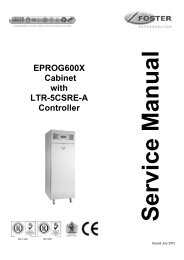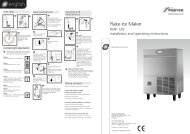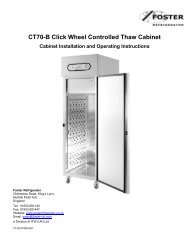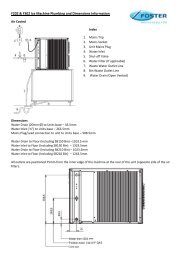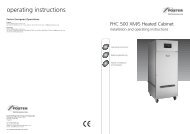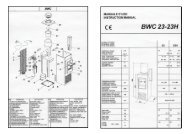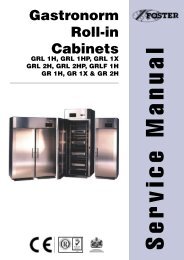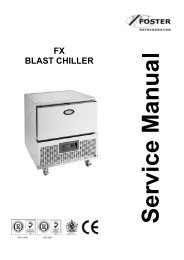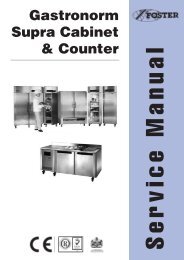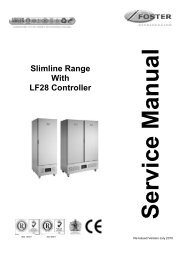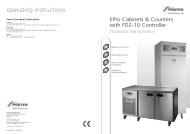Blast Chillers & Freezers - Foster Spares & Service
Blast Chillers & Freezers - Foster Spares & Service
Blast Chillers & Freezers - Foster Spares & Service
You also want an ePaper? Increase the reach of your titles
YUMPU automatically turns print PDFs into web optimized ePapers that Google loves.
GB<br />
Initial Set Up<br />
After unpacking clean and allow the cabinet to stand for 2 hours before turning on.<br />
Ensure the cabinet is situated where neither hot nor cold air sources will affect its performance. Make sure that a<br />
minimum clearance of 150mm around the cabinet is available for ventilation and effective operation. There is no<br />
minimum clearance for above the cabinets. Connect the unit to a suitable mains power outlet and turn the supply<br />
on. Please note that the BCT36 will require a 16amp supply and the BCFT36 and both 51kg models will require a 3<br />
phase supply.<br />
Do not plug or unplug the unit with wet hands.<br />
Initialisation screen<br />
Home Screen<br />
After power is applied to the unit the controller display will show the initialisation<br />
screen. This will only show for a few minutes stating both ‘Booting’ and then<br />
displaying the software version at the bottom of the screen. When the controller<br />
has completed initialisation the screen will revert to the ‘Home Screen’.<br />
This is shown after initialisation and when no programmes are running. From this<br />
page a cycle can be launched. Select the cycle type by pressing the relevant<br />
cycle button and then press ‘Start’. This page also shows the date, time and<br />
current air temperature and allows access to the ‘Settings Home Screen’ and<br />
‘Information’ function.<br />
<strong>Blast</strong> Chilling is a process that reduces the temperature of cooked food quickly and safely by halting the cooking<br />
process; locking in its colour, flavour, texture and nutritional value. The Department of Health guideline states that<br />
to safely blast chill food its temperature must be reduced from +70°C to +3°C within 90 minutes.<br />
When freezing food slowly, large ice crystals are created which can damage, dry out and break down the<br />
physical structure of the food leaving you with an unrecognisable product. The process of <strong>Blast</strong> Freezing reduces<br />
the products temperature quickly from +70°C to -18°C in no more than 240 minutes therefore meaning smaller<br />
crystals form and damage to product is less likely.<br />
Pre Chill<br />
This type of chill ensures that the cabinet’s actual interior temperature is correct prior to a chill cycle. This cycle will<br />
run until either the cycle time has lapsed or the internal air temperature has been achieved (whichever occurs first).<br />
After this the controller will ensure the unit remains’ in a ‘Hold’ mode until required to start a chill cycle. Performing<br />
this Pre Chill will also improve chilling performance.<br />
Soft Chill<br />
Normally this kind of cycle is used on delicate produce such as mousse, pastries, custards, fruits and vegetables.<br />
It’s also suitable for fine or thin products.<br />
The ‘Soft Chill’ cycle rapidly, but gently, reduces the product temperature to an even +3°C by controlling the air<br />
temperature to between +0.5°C and +3.5°C. The product should never go into a minus temperature range, if so<br />
damage will occur to the product in the form of texture, consistency, appearance or even dehydration. This cycle<br />
would ideally take no longer than 90 minutes to achieve, but this is dependent on the product type and load<br />
amount.<br />
Hard Chill<br />
This is more of a general purpose cycle. ‘Hard chill’ brings food temperature down to +3°C in no more than 90<br />
minutes (depending on the product type and load). Ideally this is used for meat pies, lasagne, pasta, soups/stews<br />
and or individually portioned meals – products containing a higher fat content.<br />
3



